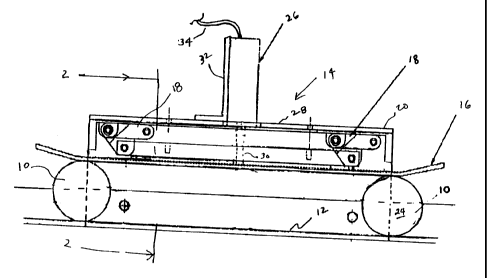Une partie des informations de ce site Web a été fournie par des sources externes. Le gouvernement du Canada n'assume aucune responsabilité concernant la précision, l'actualité ou la fiabilité des informations fournies par les sources externes. Les utilisateurs qui désirent employer cette information devraient consulter directement la source des informations. Le contenu fourni par les sources externes n'est pas assujetti aux exigences sur les langues officielles, la protection des renseignements personnels et l'accessibilité.
L'apparition de différences dans le texte et l'image des Revendications et de l'Abrégé dépend du moment auquel le document est publié. Les textes des Revendications et de l'Abrégé sont affichés :
| (12) Brevet: | (11) CA 2329222 |
|---|---|
| (54) Titre français: | DISPOSITIF DE SURVEILLANCE DE LA DETERIORATION DE ROULEAUX D'ESCALATEUR |
| (54) Titre anglais: | ESCALATOR ROLLER DEGRADATION MONITOR DEVICE |
| Statut: | Périmé |
| (51) Classification internationale des brevets (CIB): |
|
|---|---|
| (72) Inventeurs : |
|
| (73) Titulaires : |
|
| (71) Demandeurs : |
|
| (74) Agent: | RICHES, MCKENZIE & HERBERT LLP |
| (74) Co-agent: | |
| (45) Délivré: | 2007-02-13 |
| (22) Date de dépôt: | 2000-12-20 |
| (41) Mise à la disponibilité du public: | 2001-06-21 |
| Requête d'examen: | 2003-11-13 |
| Licence disponible: | S.O. |
| (25) Langue des documents déposés: | Anglais |
| Traité de coopération en matière de brevets (PCT): | Non |
|---|
| (30) Données de priorité de la demande: | ||||||
|---|---|---|---|---|---|---|
|
Dispositif de surveillance de la dégradation des rouleaux d'escalateur qui surveille le diamètre des rouleaux d'escalateur pendant que ce dernier fonctionne. Un disque à cames est installé près du rail des rouleaux aux fins de contact séquentiel avec la circonférence supérieure des rouleaux alors qu'ils se déplacent le long du rail. Le déplacement vertical des disques à cames est surveillé par un détecteur ou un capteur de proximité, les différences de pratique des disques à cames à partir des conditions de base établies signifiant des variations de diamètre des rouleaux. La sortie du détecteur ou du capteur de proximité fournit une mesure continue de l'usure et de la réduction du diamètre des rouleaux. Lorsque l'usure dépasse une valeur prédéterminée, une alarme peut être actionnée.
A roller degradation monitor device monitors the diameter of escalator rollers during operation of the escalator. A cam plate is mounted proximate the roller track for sequential contact with the upper circumference of rollers as they travel along the track. The vertical displacement of the cam plate is monitored by a proximity switch or sensor, differences in cam plate practice from an established baseline signifying variations in roller diameter. The output of the proximity switch or sensor provides a continuous measure of wear and decrease in diameter of the rollers. When the wear exceeds a predetermined value an alarm can be actuated.
Note : Les revendications sont présentées dans la langue officielle dans laquelle elles ont été soumises.
Note : Les descriptions sont présentées dans la langue officielle dans laquelle elles ont été soumises.

Pour une meilleure compréhension de l'état de la demande ou brevet qui figure sur cette page, la rubrique Mise en garde , et les descriptions de Brevet , États administratifs , Taxes périodiques et Historique des paiements devraient être consultées.
| Titre | Date |
|---|---|
| Date de délivrance prévu | 2007-02-13 |
| (22) Dépôt | 2000-12-20 |
| (41) Mise à la disponibilité du public | 2001-06-21 |
| Requête d'examen | 2003-11-13 |
| (45) Délivré | 2007-02-13 |
| Expiré | 2020-12-21 |
Il n'y a pas d'historique d'abandonnement
Les titulaires actuels et antérieures au dossier sont affichés en ordre alphabétique.
| Titulaires actuels au dossier |
|---|
| INVENTIO AG |
| Titulaires antérieures au dossier |
|---|
| BONITZ, WILLIAM |
| FRAZIER, ROGER L. |
| KAO, MICHAEL D. |
| NORTH, ROBERT T. |
| SMITH, MELANIE JEAN |
| VON OFFERMAN, KIRK |